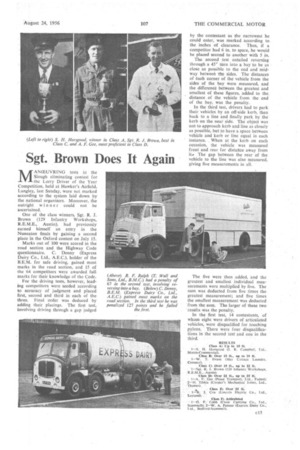Sgt. Brown Does It Again
Page 53

If you've noticed an error in this article please click here to report it so we can fix it.
M ANCELIVRING tests in the Slough eliminating contest for
• the Lorry Driver of the Year Competition. held at Hawker's Airfield, Langley, last Sunday, were not marked according to the system laid down by the national organizers. Moreover, the outright winner could not be ascertained.
One of the class winners. Sgt. R. J. Brown (129 Infantry Workshops, R.E.M.E., Austin), had previously earned himself an entry in the Nuneaton finals by gaining a second place in the Oxford contest on July 15.
Marks out of 100 were scored in the road section and the Highway Code questionnaire. C. Denny (Express Dairy Co., Ltd., A.E.C.), holder of the B.E.M. for safe driving, gained most marks in the road section, and 15 of the 64 competitors were awarded full marks for their knowledge of the Code.
For the driving tests, however, leading competitors were seeded according to accuracy of judgment and placed first, second and third in each of the three. Final order was deduced by adding their placings. The first test, involving driving through a gap judged
by the contestant as the narrowest he could enter, was marked according to the inches of clearance. Thus, if a competitor had 6 in. to spare, he would be placed second to another with 5 in.
The second test entailed reversing through a 45° turn into a bay to be as close as possible to the end and midway between the sides. The distances of each corner of the vehicle from the sides of the bay were measured, and the difference between the greatest and smallest of these figures, added to the, distance of the vehicle from the end of the bay, was the penalty.
In the third test, drivers had to park their, vehicles by an off-side kerb, then back to a line and finally park by the kerb on the near' side. The object was not to approach kerb and line as closely as possible, but to have a space between vehicle and kerb or line equal in each instance. When at the kerb on each occasion, the vehicle was measured front and rear for distance away from it.. The gap between the rear of the vehicle to the line was also measured, giving five measurements in all.
The five were then added, and the greatest and smallest individual measurements were multiplied by five. The sum was deducted from five times the greatest measurement; and five times the smallest measurement was deducted from the sum. The larger of these two -results was the penalty.
In the first test, 14 contestants, of whom eight were drivers of articulated vehicles, were disqualified for touching pylons. There were four disqualifications in the second test and one in the third.












































































































